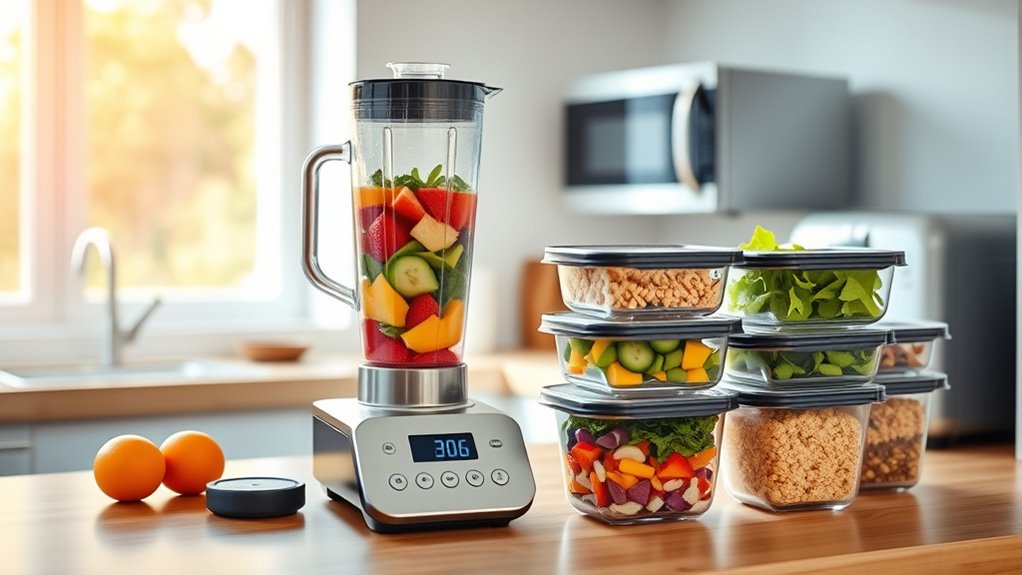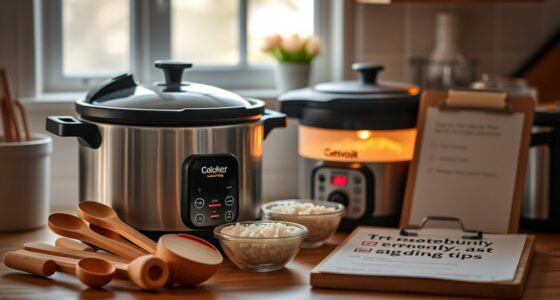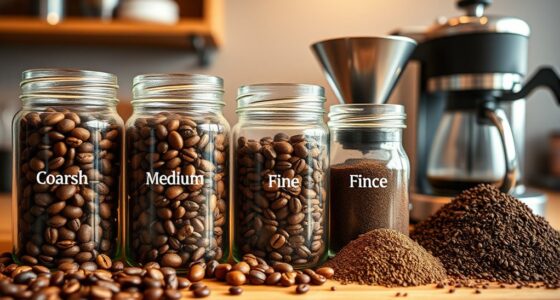To effectively use small appliances for meal prepping and portion control, leverage your blender for quick smoothies, soups, and sauces, and pre-portion servings in containers for convenience. Use your slow cooker to prepare large batches of stews, chili, or grains ahead of time, then divide into meal-sized portions. Combining these tools saves time, reduces daily cooking stress, and helps maintain balanced diets. Keep exploring how to maximize these appliances to simplify your meal routine even further.
Key Takeaways
- Use blenders to prepare smoothies, soups, and sauces in advance, dividing into portioned containers for easy grab-and-go meals.
- Utilize slow cookers for batch cooking hearty dishes, then portion into containers for meal prep throughout the week.
- Pre-portion meals and snacks with appliances to maintain portion control and support balanced diets.
- Combine appliances to streamline meal prep, reducing daily cooking time and ensuring a variety of nutritious options.
- Label and organize pre-prepared portions to enhance meal planning, encourage consistency, and simplify dietary tracking.

Meal prepping can save you time and money, and the right small appliances make the process much easier. When you’re planning out your meals for the week, having versatile tools like a good blender can be a game-changer. Blenders aren’t just for smoothies; they can quickly puree soups, make sauces, or whip up healthy snacks, saving you prep time and reducing the need for multiple appliances. This versatility allows you to prepare ingredients in advance, blend smoothies or soups directly into storage containers, and streamline your cooking routine. Plus, a powerful blender can handle different textures and ingredients, making it a reliable centerpiece for meal prep.
A versatile blender simplifies meal prep by blending smoothies, soups, and sauces quickly and efficiently.
In addition to a blender, a slow cooker offers unmatched convenience. With a slow cooker, you can toss in your ingredients in the morning and come home to a ready-made, flavorful meal. Its low-and-slow cooking process helps tenderize tougher cuts of meat and meld flavors beautifully, which is perfect for batch cooking and portioning. Using a slow cooker for meal prep means you’re not tethered to the stove or oven, freeing up your time and stove space. You can prepare stews, chili, or even grains in advance and portion them out for the week. The convenience of set-it-and-forget-it cooking reduces stress and ensures you always have nutritious options available, especially during busy weekdays.
Portion control becomes more manageable when you leverage these small appliances effectively. With a blender, you can create smoothies or soups and divide them into individual containers, making it easy to grab a healthy meal on the go. The act of pre-portioning not only helps with maintaining a balanced diet but also prevents overeating. Meanwhile, a slow cooker supports meal prep on a larger scale. Once your dishes are cooked, you can portion them into containers, label, and store them in the fridge or freezer. This strategy promotes consistent portion sizes, saving you from unnecessary calorie intake and helping you stick to your dietary goals.
Using these appliances in tandem maximizes your meal prep efficiency. For example, you might blend ingredients for a smoothie in the morning, then cook a batch of chili in the slow cooker for dinner. Both appliances allow you to prepare multiple meals or snacks in advance, reducing daily cooking stress. They also help you maintain variety and nutritional balance, since you can prepare different dishes and store them in convenient portions. By investing in appliances that offer versatility and convenience, you make meal prepping less of a chore and more of an effective, enjoyable routine. Incorporating high-quality appliances can also improve the overall success of your meal prep efforts. This approach ultimately saves you time, money, and effort while supporting your health and wellness goals.
Frequently Asked Questions
How Do I Clean Small Appliances Safely After Meal Prep?
To clean small appliances safely after meal prep, follow these cleaning tips: unplug the appliance before cleaning, and avoid immersing electrical parts in water. Use a damp cloth for exterior surfaces and a soft brush or sponge for removable parts. Safety precautions include ensuring all parts are dry before reassembling and storing. Always consult the manufacturer’s instructions for specific cleaning guidance to prevent damage and guarantee safe, effective cleaning.
Can Small Appliances Replace Traditional Cookware Entirely?
Can small appliances truly replace traditional cookware? While they’re versatile for specific tasks, they can’t handle all cooking method limitations like baking, roasting, or large batch cooking. Small appliances excel in convenience and speed, but for variety and larger quantities, traditional cookware still plays an essential role. So, consider them as helpful tools rather than complete replacements, enhancing your meal prep without limiting your culinary options.
What Is the Energy Consumption of Common Small Appliances?
You’ll find that common small appliances vary in energy consumption, with most designed for energy efficiency. For example, a toaster uses around 800-1500 watts, while a smoothie blender typically consumes 300-700 watts. Checking the appliance wattage helps you manage energy use effectively. By choosing appliances with lower wattage and using them wisely, you can reduce energy costs while preparing meals efficiently.
Are There Specific Safety Tips for Using Multiple Small Appliances Simultaneously?
Like a modern-day knight, you must prioritize electrical safety when using multiple small appliances at once. To prevent appliance overload, avoid plugging too many devices into one outlet or power strip. Keep a close eye on cords to prevent tripping hazards and never leave appliances unattended. Use appliances on stable surfaces, and unplug them when not in use. Following these safety tips helps keep your kitchen safe and efficient.
How Do I Store Small Appliances to Maximize Space and Longevity?
To maximize space and longevity, you should use smart storage solutions like stacking appliances or nesting smaller ones inside larger ones. Keep cords organized with clips or ties to prevent tangling. Regular appliance maintenance, such as cleaning and inspecting cords, extends their lifespan. Store appliances in a dry, accessible area, ideally in cabinets or on shelves, ensuring they’re protected from dust and moisture for *superior* performance.
Conclusion
Using small appliances can streamline your meal prep and help control portions effortlessly. With appliances like slow cookers, blenders, and rice makers, you can save time and reduce food waste. Did you know that people who plan their meals using small appliances are 30% more likely to stick to healthy eating habits? Incorporate these tools into your routine, and you’ll find meal prep becomes quicker, easier, and more enjoyable, keeping you on track with your health goals.









